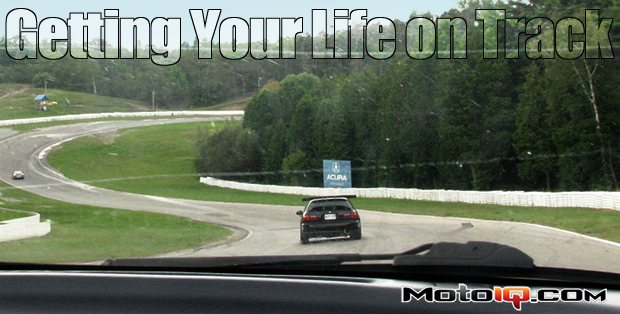,
Getting ready for the track
First Lapping Day
For your first lapping day, basic maintenance must be done. Ensure that your car is in sound mechanical condition. If there are leaks on the driveway where you park your car, do not take it anywhere near the track until you have identified and corrected the issue.
 | |
| Hatchbacks are great for loading up supplies. Do not forget to take some lunch and a lot of water! Look after yourself just like you look after your car. |
Have a good helmet. If the lapping day that you are going to does not require a helmet, I would think twice about participating. There are many cheap products out there, but buy a helmet that you know will keep you safe. M2005 is a minimum for a car without a cage; SA2005 if you have a cage. The SA stands for specialty applications and indicates that the materials in the helmet are fire rated.
Ensure that you have adequate brakes. Fresh brake fluid and lots of life left in your brake pads. If you cannot stop, you will not enjoy yourself. Fill your tires up to about 38 or 40 pounds of pressure. 32 is standard for comfort but not for aggressive cornering. Have a pressure gauge so you can check it throughout the day. Remember, it is easy to let air out but if there is not a compressor close by, impossible to add air. Remove your centre caps – especially if they are expensive ones. I stood beside a car that had been out lapping with the centre caps in place and one popped off like a gunshot due to the heat build-up. I went to my first track day with a few standard sized wrenches, an air pressure gauge, some brake fluid and engine oil. I moved up to R-compound tires, a jack, tarp, hand cleaner and sun screen. I take all that and a bit more now!
 |
| Don’t spend a lot of money before you go out and try it. Take time to get to know your neighbors in the pits. It’s amazing what you can learn from them. Plus, they will keep an eye on your stuff when you’re out on the track! |
Doing these three things – basic maintenance, safety gear, and good brakes – will ensure that you have a good lapping day. When I talk to people considering the sport I talk to them about brakes, suspension and training – before they consider adding horsepower. But do not do anything until you go out and try it. If you had fun, then you will be ready to start spending more money. If you did not have fun or scared yourself silly, at least it did not cost too much. If you did not enjoy it, I encourage you not to quit yet. Ask yourself this question – did you enjoy the people that you were sharing the track with today?
 | |
| The right seat is for a coach. Go to a performance driving school and work with a few, then go back and ask for the coach you felt helped out the most. |
Driving is a social event and if the people you are sharing the track with do not share respect for you as they fly by you in their 3000 pound missile, then you will not enjoy yourself. Look for a performance driving school where you will be out on the track with an instructor and the other participants will have a firm set of guidelines to follow. At that point, you will be able to identify if this is a sport you are interested in or not.
Subsequent Lapping Days
If you enjoyed the first outing, like any other sport it is time to start spending some money. You have your helmet and your car in fine mechanical condition. If your first day did not include a coach at a driving school, then I strongly encourage you to find a school that will teach you everything from seating position to how to corner effectively.
 | |
| You can do most hairpin turns without letting go of the 3 and 9 hand position. Also, when you spin (and that is inevitable) and recover, if your hands are still on the wheel you will know which way is straight! |
I benefited from meeting Rob Stone, driving instructor and principal owner of RESCON RACING, early in my lapping experience and the learning opportunities continue to build. From developing hand position to learning heel and toe (or in my case, left and right side of my foot). As I now am involved in coaching, I look very closely at the seating position. The seat should be upright, driver should be able to fully engage the clutch with their “right” foot and still have a slight bend in the knee, their hands should be at the three and nine o’clock positions on the steering wheel – and once moving, apart from shifting they should rarely, if ever, leave that position.
As you progress with your driving experiences on various tracks, you will find the competitive desire awakened and that means trying out different tracks in your area plus looking into autocross or time attack events. Do not rush into wheel to wheel. Take the time to get to know your car. Find out how much you can push yourself while driving it. You do not need 400 whp to drive fast on a road course. The old adage “Do you want to drive a fast car slow or a slow car fast!” truly comes into play when you’re taking your car around hairpin or decreasing radius corners. You will have more fun driving a slow car fast, you will learn more, and when you do move into a higher powered car, you will be ready to push it. It will put a smile on your face!



